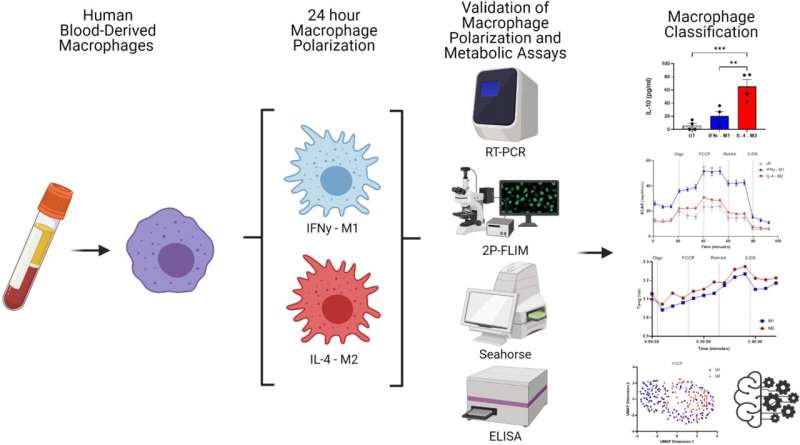New machine-learning technique for classifying key immune cells has implications for a suite of diseases


Researchers from Trinity College Dublin have developed a new, machine learning-based technique to accurately classify the state of macrophages, which are key immune cells. Classifying macrophages is important because they can modify their behavior and act as pro- or anti-inflammatory agents in the immune response. As a result, the work has many implications for research and has the potential to one day make major societal impact.
For example, this new approach could be of use to drug designers looking to create therapies targeting diseases and auto-immune conditions such as diabetes, cancer and rheumatoid arthritis—all of which are impacted by cellular metabolism and macrophage function.
Because classifying macrophages allows scientists to directly distinguish between macrophage states—based only on their metabolic response under certain conditions—this new information could be used as a diagnosis tool, or to highlight the role of a particular cell type in a disease environment.
The landmark research, which used human macrophages in experiments, was led by Michael Monaghan, Associate Professor in Biomedical Engineering at Trinity. The work brought together biomedical engineers, computer scientists and immunologists and has just been published in the journal eLife.
Professor Monaghan comments, “Currently, there are no other methods that employ artificial intelligence-based, machine learning approaches to macrophage classification. A number of different techniques are currently used to classify macrophages, but all of these have significant drawbacks.
“Our method uses a 2-photon fluorescence lifetime imaging microscope (2P-FLIM), which is unique to Trinity and to Ireland. 2P-FLIM does not require sample pre-treatment, can be used to follow changes in metabolism non-invasively and in real-time—which opens the door to tracking disease progression and/or physiological response to therapies—and it also requires a lower number of cells compared with conventional techniques.”
Nuno Neto, Ph.D. Candidate in the School of Engineering, added, “It is becoming increasingly clear that to solve many of society’s greatest problems, we need to take multi-disciplinary approaches to harness the expertise of people working in different fields.
Source: Read Full Article